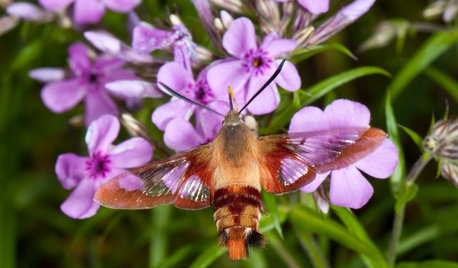Moths - Big Time!
grasswhisperer
15 years ago
Related Stories

GARDENING GUIDESHummingbird or Moth? See Why You Want Clearwings Around
These fascinating moths may be helpful pollinators for your garden. Here’s how to coax them your way
Full Story
HOUSEPLANTSOrchids 101: How to Keep Your Moth Orchids Alive and Blooming
Growing Phalaenopsis — and getting it to flower again — is easier than you might think
Full Story
GARDENING GUIDES10 Easy Edibles for First-Time Gardeners
Focus on these beginner-friendly vegetables, herbs, beans and salad greens to start a home farm with little fuss
Full Story
EDIBLE GARDENSWhy Grow Quince? For Beauty, Fragrance and Old-Time Flavor
Delightfully perfumed fruit and lovely spring blossoms make this apple and pear cousin worth a spot in the garden
Full Story
DECORATING GUIDES15 Bite-Size Home Projects You Can Tackle in No Time
See how getting little decorating, cleaning and organizing tasks done can add up to a big sense of accomplishment
Full Story
PATIOSAn Outdoor Dining Spot Creates Quiet Time in the Heart of San Francisco
See how this abandoned site became a big-city oasis with the help of a new lawn and a unique outdoor dining area
Full Story
HOUZZ TOURSHouzz Tour: From Summer Cottage to Full-Time Home
A retired NHL player and his family expand their former vacation home with a big addition and an interesting side-by-side design
Full Story
HOUSEKEEPING20 Things You Might Be Forgetting to Spring-Clean
Clean these often-neglected areas and your house will look and feel better
Full Story
DECORATING GUIDESSmall Details Make a Big Statement
Looking to refresh your home on a tight budget or with limited time? Think small. Here are 9 ideas to inspire you
Full Story
HOUZZ TOURSMy Houzz: A Texas Home Goes Big for the Kids
Part-time homeschoolers go all out to design a home focused on family, imagination and fun
Full Story







philes21
grasswhispererOriginal Author
Related Professionals
Salisbury Landscape Architects & Landscape Designers · Waunakee Landscape Architects & Landscape Designers · Arlington Landscape Contractors · Barrington Landscape Contractors · Hawthorne Landscape Contractors · Hoffman Estates Landscape Contractors · Inglewood Landscape Contractors · Ronkonkoma Landscape Contractors · South Hackensack Landscape Contractors · Tamarac Landscape Contractors · West Palm Beach Landscape Contractors · Palos Heights Landscape Contractors · Cypress Swimming Pool Builders · Dickinson Swimming Pool Builders · Englewood Swimming Pool Builderspaulinct